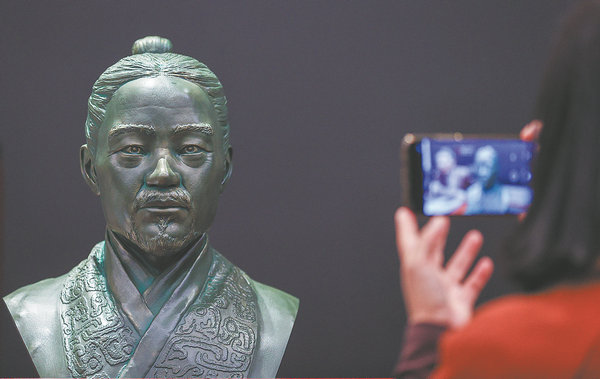

What did a grassroots official living more than 2,000 years ago look like?
A recent study unveiled by the Hubei Provincial Museum released the 3D reconstruction of the owner of a Qin Dynasty (221-206 BC) tomb unearthed at Shuihudi village, Yunmeng county in Central China's Hubei province. He is known as "Xi "according to the bamboo slips unearthed from the tomb. The reconstruction provides the vivid image of a diligent low-ranking official: handsome, well-proportioned, and showing signs of his "professionalism".
Since 2019, the Hubei Provincial Museum, together with the Hubei Provincial Institute of Cultural Relics and Archaeology and the School of Archaeology at Jilin University, has conducted comprehensive studies on the bones of the official, whose skeletal remains are well-preserved.
Wang Xianfu, deputy director of the Hubei Provincial Museum, says that the official's height is estimated to have been 161.5 centimeters and his body wight around 59.9 kilograms. He was 46 years old when he died.
"He had uneven shoulders, suffered from spondylosis, and the frequent kneeling and sitting caused damage to his lower limbs, all of which are related to his long-term engagement in historical and literary documentation and 'desk work'," said Wang at a news conference held at the end of March in Wuhan, Hubei province.
The low-ranking official is the owner of tomb No 11 at Shuihudi, Yumeng county, where dozens of Qin era and Han (206 BC-AD 220) Dynasty tombs have been discovered over the past 50 years.
When the tomb was discovered in 1975, a total of 1,155 bamboo slips recording the legal system, grassroots governance and medical work of that time were unearthed. These bamboo slips contain about 40,000 characters and were transcribed by the ancient official during his lifetime. It marked the first discovery of Qin Dynasty laws and systems, and was later selected as one of China's "Top 100 Archaeological Discoveries of the Century".
Through the bamboo slips, regulations protecting the environment and consumers' rights dating back 2,000 years were unveiled to the world, such as trees not allowed to be cut down in spring and a requirement that goods for sale should be clearly priced.
Apart from laws, the legal official had recorded his own daily life and major events from 306 BC to 217 BC, shortly after China's first emperor Qinshihuang unified the whole country.
From his own records, the official was born in 262 BC and began working for the government at the age of 19. When he was 28, he became a legal worker for a prison. He went to war three times and died at 46. The "occupational diseases" he developed, as the results of physical anthropology showed, are consistent, says Yang Lisheng, director of the academic and research center of the Hubei Provincial Museum.
"National and family affairs are meticulously recorded by the official in the form of chronicles. The stories of these 'ordinary people' are often absent from historical records, yet they can reveal the grand and tumultuous history behind them," Yang adds.
He says that his team expects to present the living conditions of a grassroots figure from history through the 3D reconstruction to outline a crucial aspect of the history of the Qin Dynasty.
Yang says that the 3D image of the legal worker will be shown to the public later this year at the Hubei Provincial Museum.